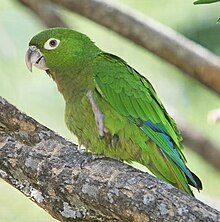Olive-throated parakeet
| Olive-throated parakeet | |
|---|---|

| |
| Eupsittula nana nana | |
| Scientific classification | |
| Kingdom: | Animalia |
| Phylum: | Chordata |
| Class: | Aves |
| Order: | Psittaciformes |
| Family: | Psittacidae |
| Genus: | Eupsittula |
| Species: | E. nana
|
| Binomial name | |
| Eupsittula nana (Vigors, 1830)
| |

| |
| Synonyms | |
|
Aratinga nana | |
The olive-throated parakeet (Eupsittula nana), also known as the olive-throated conure in aviculture, is a species of parrot in the family Psittacidae. It is found in forest and woodland in Jamaica, Mexico and Central America, and has been introduced to Hispaniola, in the Dominican Republic.
Description[]
The species has a brown throat, with orange eyes in adults and brown eyes in juveniles. Its flight call is a noisy screech; it also utters harsh twittering sounds and piercing chirps.[2] Measures 21.5–24 cm (8.5–9.4 in) and weighs 75–85 g (2.6–3.0 oz).[3]
Taxonomy and distribution[]

The species occurs in two widely disjunct populations, with the nominate subspecies restricted to Jamaica, and the astec group (including subspecies vicinalis) occurring from northeastern Mexico through the Yucatan Peninsula and along the Caribbean slope of Central America, as far south as northwestern Panama. The two populations are very similar. Most authorities consider them a single species; however, some (such as the IUCN through BirdLife International), have recommended splitting them, referring to the former as the Jamaican parakeet (E. nana) and the latter as the Aztec parakeet (E. astec).[4][5]
The nominate subspecies has recently been discovered to occur in remote areas of Hispaniola as well, with genetic analysis suggesting it may have been introduced from Jamaica.[6]
Habitat[]
The parakeet inhabits wooded hills and mountain slopes, but also makes use of cultivated areas and scrubland in humid or semi-arid areas up to moderate elevations above sea level. It is most common at heights of around 1,000 m (3,300 ft).[7]
Ecology[]
The parakeet feeds on buds and fruit as well as some crops, causing it to be considered a pest species in some areas. It reportedly nests only in arboreal termite nests found in trees of at least medium size.[7]
References[]
- ^ BirdLife International (2020). "Eupsittula nana". IUCN Red List of Threatened Species. 2020: e.T45418540A179402014. doi:10.2305/IUCN.UK.2020-3.RLTS.T45418540A179402014.en. Retrieved 15 November 2021.
- ^ "Olive-throated Conure (Eupsittula nana)". World Parrot Trust Encyclopedia.
- ^ Soberanes-González, C.; Rodríguez-Flores, C.; Arizmendi, M.C. (2010). Schulenberg, T.S. (ed.). "Olive-throated Parakeet (Eupsittula nana)". Neotropical Birds Online. Ithaca: Cornell Lab of Ornithology. Retrieved 19 March 2016.
- ^ https://avibase.bsc-eoc.org/species.jsp?avibaseid=31172F88931F3F2F
- ^ BirdLife International (2016). "Eupsittula astec". IUCN Red List of Threatened Species. 2016: e.T45418555A95148063. doi:10.2305/IUCN.UK.2016-3.RLTS.T45418555A95148063.en. Retrieved 15 November 2021.
- ^ Latta, Steven C.; Townsend, Andrea K. (January 2010). "The origins of the recently discovered Hispaniolan Olive-throated Parakeet: A phylogeographic perspective on a conservation conundrum". Caribbean Journal of Science. 46 (2): 143–149. doi:10.18475/cjos.v46i2.a2. S2CID 88153066. Retrieved 9 September 2020.
- ^ a b BirdLife International (2014). "Eupsittula nana". IUCN Red List of Threatened Species. 2014: e.T45418540A45418571. doi:10.2305/IUCN.UK.2014-2.RLTS.T45418540A45418571.en.
External links[]
| Wikimedia Commons has media related to Eupsittula nana. |
| Wikispecies has information related to Eupsittula nana. |
- BirdLife species factsheet for Eupsittula nana
- "Eupsittula nana". Avibase.

- "Olive-throated parakeet media". Internet Bird Collection.
- Olive-throated parakeet photo gallery at VIREO (Drexel University)
- Interactive range map of Eupsittula nana at IUCN Red List maps
- Audio recordings of Olive-throated parakeet on Xeno-canto.
- Eupsittula nana in Field Guide: Birds of the World on Flickr
- IUCN Red List near threatened species
- Eupsittula
- Birds of Jamaica
- Birds of Central America
- Birds of the Dominican Republic
- Birds described in 1830
